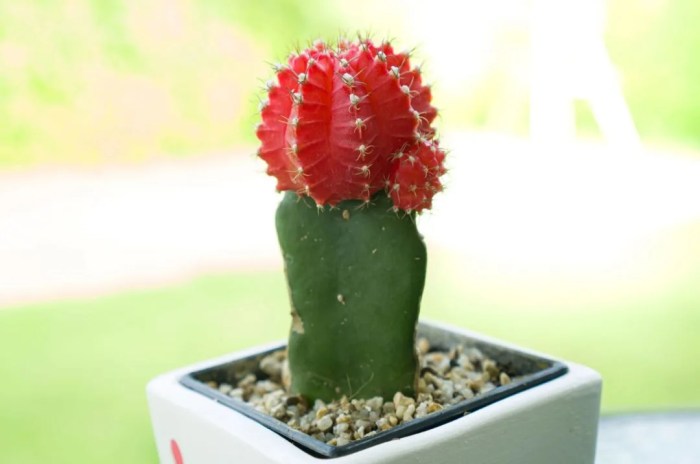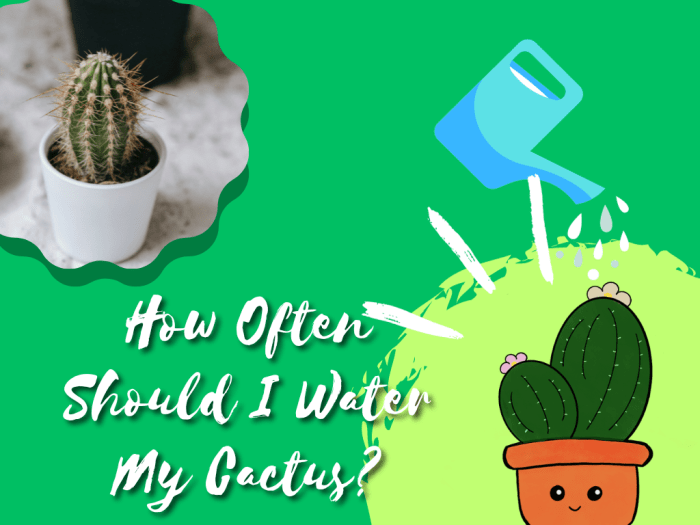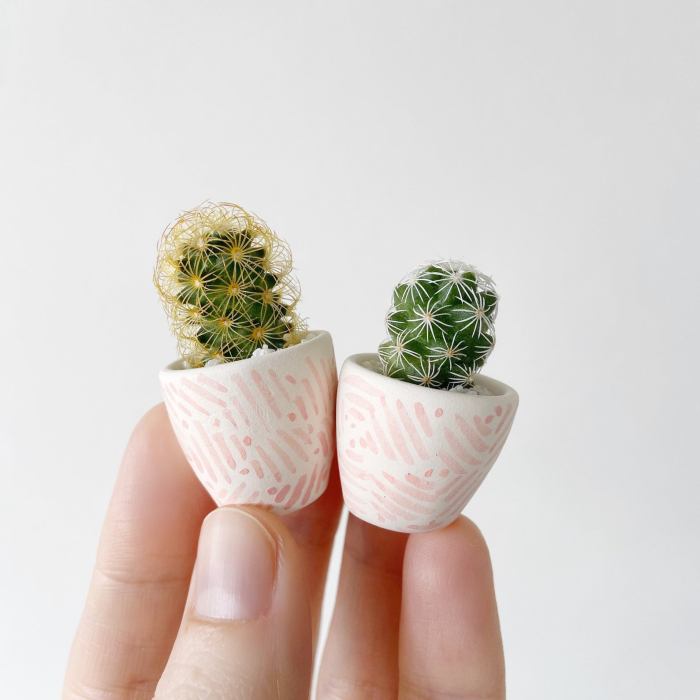How Much to Water a Cactus Plant
Cactus Watering Frequency

Source: positivebloom.com
How much to water a cactus plant – The frequency of watering your cactus depends on several interconnected factors. Understanding these factors is key to keeping your cactus thriving. Overwatering is a common problem, leading to root rot and plant death, while underwatering can cause the cactus to shrivel and become stressed.
Factors Influencing Cactus Watering Frequency
Several key elements determine how often you should water your cactus. These include the size of the pot, the specific cactus species, the current season, and the overall climate.
- Pot Size: Smaller pots dry out faster than larger ones, requiring more frequent watering. A larger pot retains moisture for a longer period.
- Cactus Species: Different cacti have varying water requirements. Desert cacti like saguaros are adapted to arid conditions and need less frequent watering than rainforest cacti, which prefer more moisture.
- Season: During the growing season (spring and summer), cacti require more frequent watering due to increased metabolic activity. In the dormant season (fall and winter), watering should be significantly reduced.
- Climate: Hot, dry climates will necessitate more frequent watering than cooler, humid environments. Consider the ambient temperature and humidity levels when planning your watering schedule.
Cactus Watering Needs Comparison
| Species | Watering Frequency (Growing Season) | Soil Type | Signs of Over/Underwatering |
|---|---|---|---|
| Saguaro (Carnegiea gigantea) | Every 2-3 weeks | Well-draining cactus mix | Overwatering: Soft, mushy base; Underwatering: Shriveled stem |
| Prickly Pear (Opuntia spp.) | Every 1-2 weeks | Sandy loam | Overwatering: Yellowing pads; Underwatering: Wrinkled pads |
| Christmas Cactus (Schlumbergera spp.) | Weekly (during blooming) | Peat-based potting mix | Overwatering: Leaf drop; Underwatering: Wilting stems |
| Barrel Cactus (Echinocactus spp.) | Every 2-4 weeks | Fast-draining mineral mix | Overwatering: Soft spots on the barrel; Underwatering: Shrunken barrel |
Yearly Cactus Watering Schedule
A general guideline for watering cacti throughout the year is to water deeply but infrequently during the growing season (spring and summer) and significantly reduce watering during the dormant season (fall and winter). Adjust this schedule based on the factors discussed above.
- Spring/Summer: Water thoroughly when the top inch of soil is dry. Frequency depends on factors mentioned above.
- Fall/Winter: Reduce watering frequency to once a month or even less, depending on the climate and species. Avoid watering altogether if the cactus is in a cool, dry environment.
Determining Soil Moisture
Accurately assessing soil moisture is crucial to avoid overwatering or underwatering your cactus. Several methods can help determine the moisture level.
Soil Moisture Testing Methods
There are a few reliable methods to check soil moisture before watering your cactus. These include the finger test and using a moisture meter.
- Finger Test: Insert your finger about an inch into the soil. If it feels dry, it’s time to water. If it’s still moist, wait a few days.
- Moisture Meter: A moisture meter provides a more precise measurement. Insert the probe into the soil and read the moisture level indicated on the meter.
The finger test is a simple and readily available method, while a moisture meter offers a more quantitative assessment. The best approach depends on your preference and the level of precision desired.
Visual Guide to Cactus Soil Moisture
Properly watered cactus soil will feel slightly moist but not soggy. Overwatered soil will be saturated and potentially show signs of mold or mildew. Underwatered soil will be completely dry and possibly cracked.
Imagine a visual representation: A properly watered cactus would have soil that’s evenly moist, dark brown in color, and crumbly to the touch. Overwatered soil would be dark, muddy, and compacted. Underwatered soil would be light brown, dusty, and dry, possibly pulling away from the pot’s sides.
Watering Techniques

Source: houseplantjoy.com
Different watering techniques can impact the health of your cactus. Understanding the advantages and disadvantages of each method helps you choose the best approach for your plants.
Appropriate Watering Techniques, How much to water a cactus plant
Three common methods are top watering, bottom watering, and soaking. Each has its pros and cons.
- Top Watering: This involves gently pouring water over the soil surface. It’s the most common method but can sometimes lead to soil erosion if done improperly.
- Bottom Watering: This involves placing the pot in a shallow dish of water, allowing the soil to absorb moisture from the bottom. This method helps prevent overwatering but is less effective for very dry soil.
- Soaking: This involves thoroughly saturating the soil until water drains from the drainage holes. This is a good method for deeply watering the root system, but it needs to be done carefully to avoid overwatering.
Step-by-Step Guide to Top Watering a Cactus
A detailed description of top watering a cactus:
- Gently pour lukewarm water onto the soil surface, avoiding the cactus body itself. Ensure the water reaches the edge of the pot.
- Continue watering until water begins to drain from the drainage holes. This indicates the soil is thoroughly saturated.
- Allow any excess water to drain completely before returning the pot to its usual location. Do not leave the cactus sitting in standing water.
- Observe the soil’s moisture level in the following days using the finger test or moisture meter. This helps determine the next watering time.
A visual guide would show each step clearly, with the first step showing a watering can poised above the soil, the second showing water draining from the pot, and the third showing the pot with no standing water.
Signs of Overwatering and Underwater
Recognizing the signs of overwatering and underwatering is crucial for timely intervention and preventing cactus damage.
Visual Signs of Overwatering and Underwater

Source: purewow.net
Overwatering and underwatering manifest differently in cacti. Understanding these differences is essential for proper care.
- Overwatering: Soft, mushy stems or pads; yellowing or browning of the plant; root rot (evident upon inspection); foul odor from the soil.
- Underwatering: Shriveled or wrinkled stems or pads; dry, brittle soil; leaf drop (in some species); stunted growth.
Preventative Measures and Solutions
Preventing both overwatering and underwatering requires careful monitoring and appropriate watering practices.
- Overwatering Prevention: Use well-draining soil; ensure proper drainage holes in the pot; avoid watering too frequently; allow the soil to dry completely between waterings.
- Underwatering Prevention: Water deeply when the soil is dry; adjust watering frequency based on environmental conditions; monitor the plant regularly for signs of stress.
Solutions include repotting in well-draining soil if overwatering is suspected. For underwatering, a thorough watering and increased monitoring is usually sufficient.
Cactus Potting and Drainage
Proper potting and drainage are essential for a healthy cactus. The right pot and soil mix ensure proper aeration and prevent waterlogging.
Importance of Drainage
Good drainage prevents water from accumulating around the roots, reducing the risk of root rot. Drainage holes in the pot allow excess water to escape, keeping the soil aerated and preventing waterlogging.
Suitable Potting Mixes
A well-draining cactus potting mix is crucial. Several options exist, each with its advantages.
- Commercial Cactus Mix: Readily available and formulated for optimal drainage.
- DIY Mix: Combine equal parts potting soil, coarse sand, and perlite for excellent drainage and aeration.
Repotting a Cactus
Repotting is necessary when the cactus outgrows its current container or if the soil is compacted or degraded. This process involves carefully removing the cactus from its pot, inspecting the roots, and planting it in fresh, well-draining soil in a pot with drainage holes.
A step-by-step guide would involve removing the cactus, carefully inspecting the roots for any signs of rot, planting in fresh soil in a new pot with drainage holes, and ensuring that the cactus is planted at the same depth as before.
Environmental Factors: How Much To Water A Cactus Plant
Sunlight, temperature, and humidity significantly influence a cactus’s water needs. Understanding these factors is crucial for proper watering.
Impact of Sunlight, Temperature, and Humidity
Environmental conditions directly impact how frequently a cactus needs watering.
- Sunlight: Increased sunlight exposure leads to increased water evaporation from the soil, requiring more frequent watering.
- Temperature: Hot temperatures increase evaporation rates, while cooler temperatures reduce them, affecting watering frequency.
- Humidity: High humidity reduces the need for frequent watering, as less water is lost through evaporation.
Optimal Environmental Conditions
A chart detailing the optimal environmental conditions for different cactus species would include information on sunlight needs (full sun, partial shade), ideal temperature ranges, and preferred humidity levels. This would help to create a more precise watering schedule based on the specific needs of each plant.
FAQ Insights
Can I use tap water to water my cactus?
It’s best to use filtered or distilled water, as tap water can contain minerals that may harm your cactus. Allow tap water to sit out for 24 hours to allow chlorine to dissipate.
How often should I fertilize my cactus?
Fertilize cacti sparingly, typically only during the growing season (spring and summer) with a balanced, diluted cactus fertilizer.
My cactus is drooping, is it underwatered or overwatered?
Drooping can indicate both. Check the soil; if dry, it’s likely underwatered. If soggy, it’s probably overwatered. Examine the roots for signs of rot.
What type of pot is best for a cactus?
Terracotta pots are ideal as they allow for better drainage and airflow, preventing root rot.





















